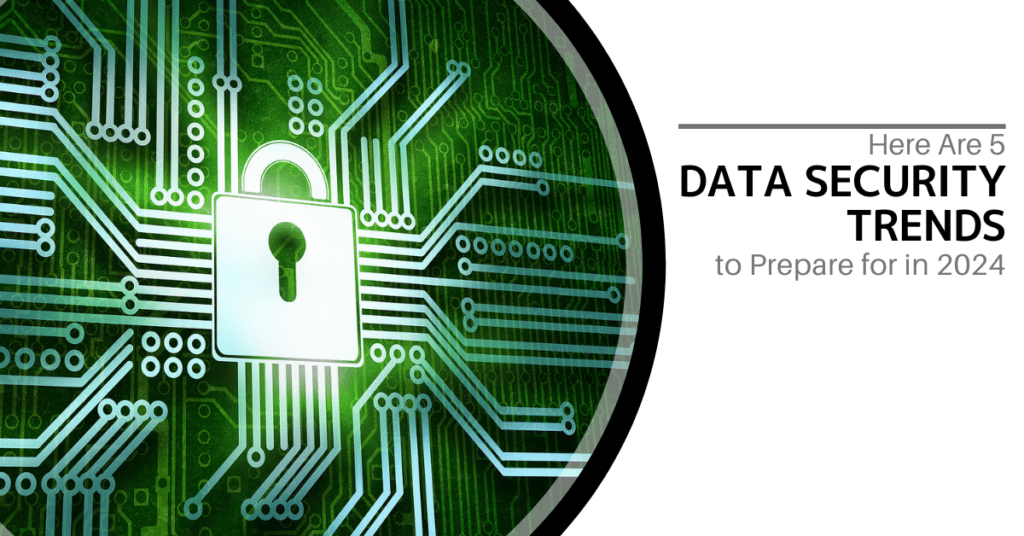|
Getting your Trinity Audio player ready...
|

With cyber threats evolving rapidly, staying ahead of the curve is essential for protecting sensitive information. The complexity and frequency of data security threats are increasing, necessitating changes in the security landscape. In 2024, we anticipate both exciting advancements and ongoing challenges in data security.
Over 70% of business professionals report that their data privacy efforts yield significant or very significant benefits for their organizations. Staying informed about these trends is crucial, whether you’re an individual or a business safeguarding valuable data.
Here are some key areas to watch.
1. The Rise of AI and Machine Learning in Security
Artificial intelligence (AI) and machine learning (ML) are no longer futuristic concepts; they are actively shaping the cybersecurity landscape. This year, we can expect their application to increase:
- Enhanced Threat Detection: AI and ML algorithms excel at analyzing vast datasets, identifying patterns and anomalies that might go unnoticed by humans. This leads to quicker detection and response to potential cyber threats.
- Predictive Analytics: By analyzing past cyberattacks and security incidents, AI can predict potential vulnerabilities and suggest proactive measures.
- Automated Response: AI can be programmed to automatically isolate compromised systems, block malicious activities, and trigger incident response procedures, saving time and reducing the impact of attacks.
While AI and ML offer significant benefits, they are tools that require skilled professionals to interpret the data and make informed decisions.
2. Battling the Ever-Evolving Threat of Ransomware
Ransomware, which encrypts data and demands a ransom for decryption, remains a persistent threat. In 2024, we can expect hackers to refine their tactics further:
- More Targeted Attacks: Hackers will likely focus on high-value targets such as critical infrastructure or businesses with sensitive data to maximize their impact and potential payout.
- Ransomware-as-a-Service (RaaS): This allows individuals with limited technical expertise to rent ransomware tools, making it easier for a wider range of actors to launch attacks.
- Double Extortion: Attackers might steal data before encrypting it and threaten to leak it publicly if the ransom isn’t paid, adding pressure on victims.
3. Shifting Strategies: Earlier Data Governance and Security Action
Traditionally, data security measures were deployed later in the data lifecycle. In 2024, a shift towards earlier action is gaining traction:
- Embedding Security Early On: Organizations are integrating data controls and measures at the start of the data journey. This includes setting data classification levels, access restrictions, and data retention policies early in the process.
- Cloud-Centric Security: As more organizations move to cloud storage and processing, security solutions will be closely integrated with cloud platforms to ensure consistent security throughout the data lifecycle.
- Compliance Focus: With increasingly stringent data privacy regulations like GDPR and CCPA, companies must focus on data governance to ensure compliance.
4. Building a Fortress: Zero Trust Security and Multi-Factor Authentication
In a world where traditional perimeter defenses are constantly breached, the “Zero Trust” approach is gaining prominence. This security model assumes that no user or device is inherently trustworthy, requiring verification for every interaction:
- Continuous Verification: Every access request is rigorously scrutinized, regardless of its origin. Verification is based on factors like user identity, device, location, and requested resources.
- Least Privilege Access: Users are granted the lowest access level needed to perform their tasks, minimizing potential damage if credentials are compromised.
- Multi-Factor Authentication (MFA): MFA adds an extra layer of security, requiring users to provide additional factors beyond their password.
5. Protecting Biometric Data
Biometrics, such as facial recognition, fingerprints, and voice patterns, are becoming popular for authentication. However, this raises concerns about potential misuse and privacy violations:
- Secure Storage Is Key: Companies must store and secure biometric data, ideally in encrypted form, to prevent unauthorized access or breaches.
- Strict Regulation: Governments are expected to implement stricter regulations around the collection, use, and retention of biometric data. Organizations must adhere to evolving standards, focusing on transparency and user consent.
How to Prepare for Evolving Data Security Trends
Feeling overwhelmed? Here are some practical steps you and your organization can take:
- Stay Informed
- Invest in Training
- Review Security Policies
- Embrace Security Technologies
- Test Your Systems
Schedule a Data Security Assessment Today!
The data security landscape of 2024 promises to be both intriguing and challenging. We can help you navigate this evolving terrain with confidence. Contact us today to schedule a data security assessment.
Twintel has grown into an expansive, full team of IT services professionals, acting as the outsourced IT department of non-profits, small to mid-size businesses, and enterprise-level corporations in Orange County, across California, and nationally.
Today, it’s the strength and deep expertise of the Twintel team that drives positive outcomes for clients. Each of the support staff, technicians, and engineers works diligently each day to make sure that the companies served have the seamless, secure, and stable IT environments needed to allow them to pursue their organizational objectives.